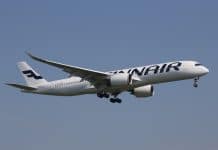In January, most passenger traffic figures clearly improved year-on-year, total month-on-month figures remained almost unchanged; cargo performance still good
In January, Finnair carried 816,200 passengers, which was 80.9% more than in January 2022 but 2.0% less than in December 2022.
The negative impact of the Russian airspace closure on Asian passenger traffic figures, which are still affected by the COVID-19 pandemic, was visible in January. The distance-based reported traffic figures do not take into account longer routings caused by the airspace closure as they are based on Great-Circle distance.
Finnair’s cooperation with Qatar Airways began on 1 November 2022 as daily flights operated by Finnair from Copenhagen and Stockholm to Doha commenced. Daily Helsinki – Doha flights started in mid-December. Related traffic figures are reported by Finnair and were visible in the European figures until the end of 2022. Starting from 2023, a new traffic area, “Middle East”, is used and these flights – as well as flights to Dubai and Israel – are now reported as part of this traffic area.
The overall capacity, measured in Available Seat Kilometres (ASK), increased in January by 19.4% year-on-year and by 0.5% month-on-month. Finnair’s traffic, measured in Revenue Passenger Kilometres (RPKs), increased by 91.0% year-on-year but decreased 0.2% month-on-month. The Passenger Load Factor (PLF) increased by 27.1% points year-on-year but decreased by 0.6% points month-on-month to 72.2%.
The ASK increase in Asian traffic was 25.8% year-on-year. The North Atlantic capacity decreased by 42.8% as the operations between Stockholm and the North American destinations were discontinued at the end of October. In European traffic, the ASKs were up by 24.5% whereas the Middle Eastern capacity increased by 687.1% due to the Qatar Airways cooperation. The ASKs in domestic traffic increased by 26.4%.
RPKs increased in Asian traffic by 142.9% year-on-year but declined in North Atlantic traffic by 3.4%. In European traffic, RPKs increased by 67.9%, in Middle Eastern traffic by 729.8% and in domestic traffic by 53.9%.
In January, the PLF improved particularly in Asian traffic (75.2%) and North Atlantic traffic (65.8%) year-on-year. The PLF was 71.5% in European traffic, 74.3% in Middle Eastern traffic and 65.8% in domestic traffic.
Passenger numbers increased in Asian traffic by 152.0% year-on-year. In North Atlantic traffic, the number of passengers decreased by 4.7%. In European traffic, passenger numbers increased by 69.8%, in Middle Eastern traffic by 745.1% and in domestic traffic by 67.7%.
As a result of the Russian airspace closure and a very strong comparison period, many cargo figures declined year-on-year in January. Available scheduled cargo tonne kilometres increased by 0.7% year-on-year but revenue scheduled cargo tonne kilometres decreased by 7.5%. Good demand for cargo capacity continued in January, even though the total cargo tonnes (including cargo-only operations) decreased by 24.7% year-on-year as Finnair operated several cargo-only flights during January 2022. Month-on-month decline, mainly caused by seasonality, was 12.4%.
In January, 81.2% of all Finnair flights arrived on schedule (63.1%).
Traffic statistics for February 2023 will be published on Tuesday 7 March 2023.
| Finnair Traffic Performance January 2023 | ||||
| Month | % Change | YTD | % Change | |
| Total traffic | ||||
| Passengers 1,000 | 816.2 | 80.9 | 816.2 | 80.9 |
| Available seat kilometres mill | 2,892.6 | 19.4 | 2,892.6 | 19.4 |
| Revenue passenger kilometres mill | 2,087.4 | 91.0 | 2,087.4 | 91.0 |
| Passenger load factor % | 72.2 | 27.1p | 72.2 | 27.1p |
| Cargo tonnes total | 9,456.2 | -24.7 | 9,456.2 | -24.7 |
| Available tonne kilometres mill | 412.9 | -0.7 | 412.9 | -0.7 |
| Revenue tonne kilometres mill | 226.0 | 21.6 | 226.0 | 21.6 |
| Asia | ||||
| Passengers 1,000 | 108.5 | 152.0 | 108.5 | 152.0 |
| Available seat kilometres mill | 1,077.6 | 25.8 | 1,077.6 | 25.8 |
| Revenue passenger kilometres mill | 810.7 | 142.9 | 810.7 | 142.9 |
| Passenger load factor % | 75.2 | 36.3p | 75.2 | 36.3p |
| Europe | ||||
| Passengers 1,000 | 447.7 | 69.8 | 447.7 | 69.8 |
| Available seat kilometres mill | 1,022.5 | 24.5 | 1,022.5 | 24.5 |
| Revenue passenger kilometres mill | 730.8 | 67.9 | 730.8 | 67.9 |
| Passenger load factor % | 71.5 | 18.5p | 71.5 | 18.5p |
| North Atlantic | ||||
| Passengers 1,000 | 27.3 | -4.7 | 27.3 | -4.7 |
| Available seat kilometres mill | 323.1 | -42.8 | 323.1 | -42.8 |
| Revenue passenger kilometres mill | 212.6 | -3.4 | 212.6 | -3.4 |
| Passenger load factor % | 65.8 | 26.8p | 65.8 | 26.8p |
| Middle East | ||||
| Passengers 1,000 | 47.8 | 745.1 | 47.8 | 745.1 |
| Available seat kilometres mill | 286.4 | 687.1 | 286.4 | 687.1 |
| Revenue passenger kilometres mill | 212.9 | 729.8 | 212.9 | 729.8 |
| Passenger load factor % | 74.3 | 3.8p | 74.3 | 3.8p |
| Domestic | ||||
| Passengers 1,000 | 184.9 | 67.7 | 184.9 | 67.7 |
| Available seat kilometres mill | 183.1 | 26.4 | 183.1 | 26.4 |
| Revenue passenger kilometres mill | 120.5 | 53.9 | 120.5 | 53.9 |
| Passenger load factor % | 65.8 | 11.8p | 65.8 | 11.8p |
| Cargo traffic | ||||
| Europe tonnes | 1,277.6 | 18.3 | 1,277.6 | 18.3 |
| North Atlantic tonnes | 1,312.3 | -41.2 | 1,312.3 | -41.2 |
| Middle East tonnes | 1,815.8 | 420.9 | 1,815.8 | 420.9 |
| Asia tonnes | 4,991.9 | -9.8 | 4,991.9 | -9.8 |
| Domestic tonnes | 31.4 | 6.1 | 31.4 | 6.1 |
| Cargo scheduled traffic total tonnes | 9,428.9 | 2.2 | 9,428.9 | 2.2 |
| Cargo flights tonnes** | 27.2 | -99.2 | 27.2 | -99.2 |
| Cargo traffic tonnes total | 9,456.2 | -24.7 | 9,456.2 | -24.7 |
| Available tonne kilometres* mill | 115.9 | -21.5 | 115.9 | -21.5 |
| Revenue tonne kilometres mill | 58.5 | -33.7 | 58.5 | -33.7 |
| Available sched. cargo tonne kms* mill | 115.5 | 0.7 | 115.5 | 0.7 |
| Revenue sched. cargo tonne kms mill | 58.3 | -7.5 | 58.3 | -7.5 |
| Cargo load factor* % | 50.5 | -9.3p | 50.5 | -9.3p |
| – North-Atlantic cargo load factor* % | 53.2 | 6.3p | 53.2 | 6.3p |
| – Asia cargo load factor* % | 54.7 | -9.8p | 54.7 | -9.8p |
| Scheduled traffic cargo load factor* % | 50.5 | -4.5p | 50.5 | -4.5p |
* Based on average operational cargo capacity
** Including purchased traffic
- Change %: Change compared to the figures of the respective periods in the previous year (p = points, N/A = not available).
- Available seat kilometres. ASK: Total number of seats available multiplied by kilometres flown.
- Revenue passenger kilometres. RPK: Number of revenue passengers carried multiplied by kilometres flown.
- Passenger load factor: Share of revenue passenger kilometres of available seat kilometres.
- Available tonne-kilometres. ATK: Number of tonnes of capacity for carriage of passengers, cargo and mail multiplied by kilometres flown.
- Revenue tonne-kilometres. RTK: Total revenue load consisting of passengers, cargo and mail multiplied by kilometres flown.
- Overall load factor: Share of revenue tonne-kilometres of available tonne-kilometres.


